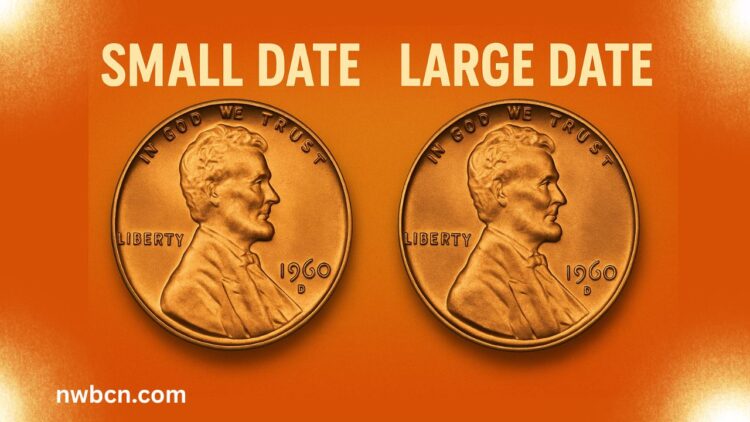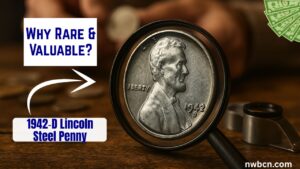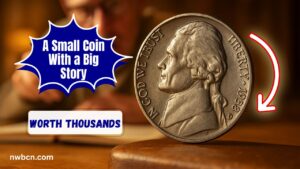In 1960, the U.S. Mint issued Lincoln pennies at Philadelphia (no mint mark) and Denver (D) featuring two distinct date styles: the Small Date and the Large Date.
Though subtle at first glance, this variation significantly affects their rarity, collector demand, and market value. Understanding these differences is crucial for numismatists and pocket-change explorers alike.
How to Tell the Difference: Date Diagnostics
According to expert guidelines, here are the definitive design features that distinguish Small from Large Date pennies:
- “6” Tail Length
- Large Date: Long, sweeping tail.
- Small Date: Shorter tail, more compact.
- Relative Height of “1”
- Small Date: The top of the “1” aligns with the top of the “9”.
- Large Date: The “1” sits lower than the “9”.
- Shape of the “0”
- Large Date: Almost perfectly round.
- Small Date: Slightly narrower “0”.
These traits apply to both business-strike and proof versions of the 1960 penny.
Production Numbers: Mintage Snapshot
| Mint & Date Style | Estimated Mintage |
|---|---|
| 1960-P Small Date | ≈ 38 million (Jan & Mar) per analysis |
| 1960-D Small Date | ≈ 242 million (grouped period) |
| 1960-P Large Date | Bulk of 586 million total |
| 1960-D Large Date | Majority of 1.58 billion |
CoinWeek estimates illustrate that Small Date pennies were produced only early in 1960, making them far less common than their Large Date counterparts.
Value Comparison: Small vs. Large Date
| Type & Grade | Large Date Value | Small Date Value |
|---|---|---|
| Circulated (VF-XF) | $0.05–$0.15 | $0.25–$0.75 |
| Uncirculated (MS60–63) | $1–$3 per roll | $50–$150 per roll (P) |
| Proof Coin (PR65) | $10–$25 | $50–$100 |
| Proof High Grade (PR68CAM) | — | $228 (PCGS PR68CAM example) |
High-End Proof Varieties: Over Date Types
Alongside the Small and Large Date, rare proof over-date errors exist:
- Small Date over Large Date
- Large Date over Small Date
These varieties are identified by faint overlapping numerals and typically priced from $160 for PR65 to around $1,500–$2,000 for PR67–PR68 Cameo examples.
Why the Date Difference Matters
- Short production window: The Small Date was used only early in 1960.
- Collector awareness: Errors and date variations are popular among hobbyists.
- Proof premium: Proof Small Date coins are rarer within annual mint sets.
- Speculator market: Reports from early 1960 sparked short-lived premiums in rolls and circulation.
Identification Guide: Spotting the Right Penny
- Magnify the numbers: Research coin images to compare digits precisely.
- Check both business and proof strikes for consistent date traits.
- Use grading slabs: Certified Small Date proofs (PR68CAM) command top prices.
- Look for over-date examples: Faint secondary date impressions are telltale signs.
Detailed Comparisons: Small vs Large Date
| Feature | Small Date | Large Date |
|---|---|---|
| Tail of “6” | Short tail | Long sweeping tail |
| Numeral height (“1”) | Aligns with “9” | Lower than “9” |
| Shape of “0” | Skinny, oval | Round, wide |
| Production Timing | Jan–early Mar 1960 | Mid–late 1960 |
| Rarity | Scarce, early-run issue | Abundant, year-round |
| Premium in MS rolls | ≈ $50–$150 (P mint) | $1–$3 |
| Proof PR68CAM value | $228+ | $50–$75 |
Key production numbers: 2.075 million small date cents from Philadelphia in January; 73 million first batch from Denver; further 168 million in February; 36 million more in Philadelphia in March.
1960 Lincoln Penny Date Variety Overview
| Variety | Mint & Period | Rarity Level | Collector Value |
|---|---|---|---|
| 1960-P Small Date | Jan–Mar 1960 (Phila) | Rare | $50–$150 per BU roll; proof premiums |
| 1960-D Small Date | Jan–Feb 1960 (Denver) | Less rare | $10–$30 unstated; BU premium moderate |
| 1960-P Large Date | Mid–1960 (Phila) | Common | Few cents each |
| 1960-D Large Date | Mid–1960 onward | Very Common | Few cents each |
| Proof over-date varieties | Proof sets early 1960 | Very Rare | $160–$2,000+ depending on grade |
What Influences Value Fluctuations
- Condition: Uncirculated and proof grades see biggest premiums.
- Mint mark: Philadelphia Small Date rarer than Denver.
- Over-date errors add notable collector intrigue and value.
- Certification: PR68CAM proofs and highly graded business strikes fetch the most.
Tips for Collectors
- Search rolls from Jan–Mar 1960 for Small Date pennies.
- Use proper lighting and magnifiers to check numerals.
- Learn proof die variations: Small date proofs and over-date proofs are easy to miss.
- Seek graded Penny mailers; authentication improves market trust.
- Follow auction pricing: Heritage and GreatCollections set benchmarks.
The seemingly innocuous date size on a 1960 Lincoln penny tells a nuanced story of minting processes, collector behavior, and value. From subtle design shifts to rare proof anomalies, the Small Date vs. Large Date – and especially the over-date proofs – carry significance far beyond face value.
Whether tucked away in pocket change or preserved in a graded slab, these small-date treasures continue to fascinate and reward those who know how to look
FAQs
Q1: How rare is the 1960-P Small Date penny?
Very. Only a small portion of the first 1960 production used the Small Date style, making BU rolls worth $50–$150.
Q2: What’s the difference between proof and business strikes?
Business-strike pennies were made for circulation; proof coins were struck for collectors with polished dies and varying finishes—proof Small Date coins are rarer and more valuable.
Q3: What are Small Date over Large Date varieties?
These are rare proof die errors showing ghosted small-date digits under a large-date outline. High-grade examples can fetch $1,500–$2,000+




